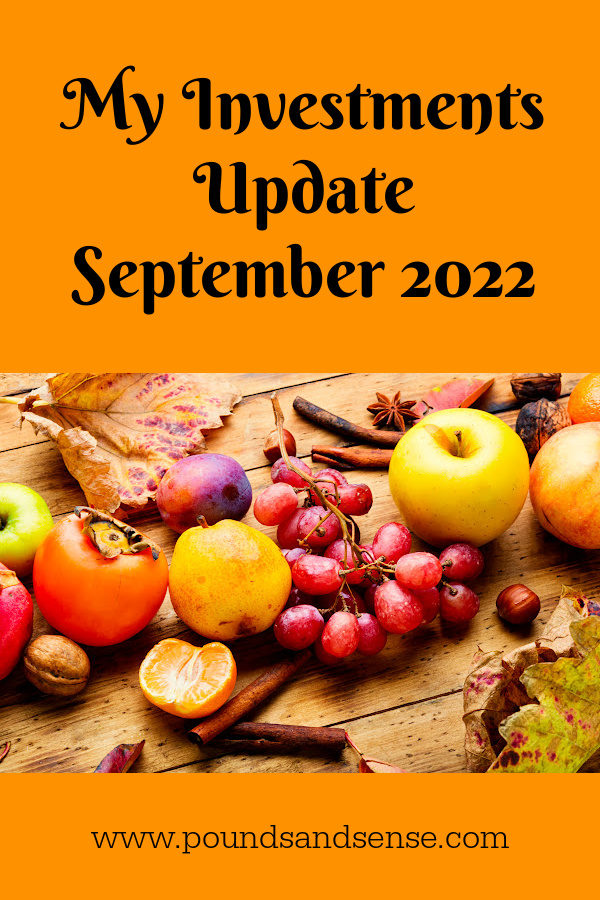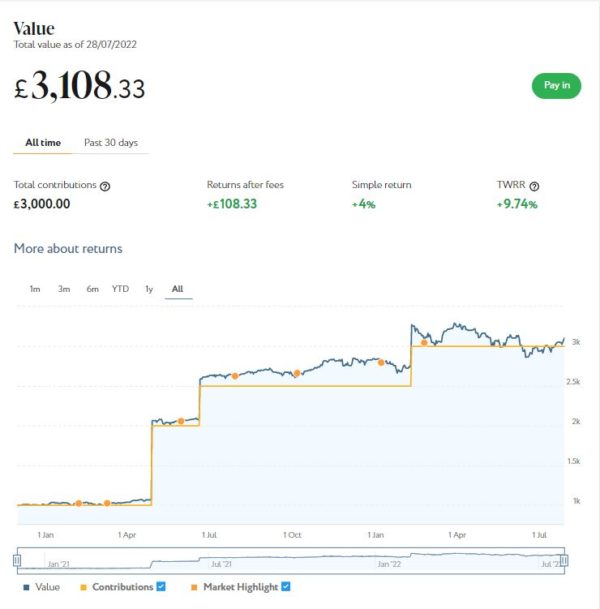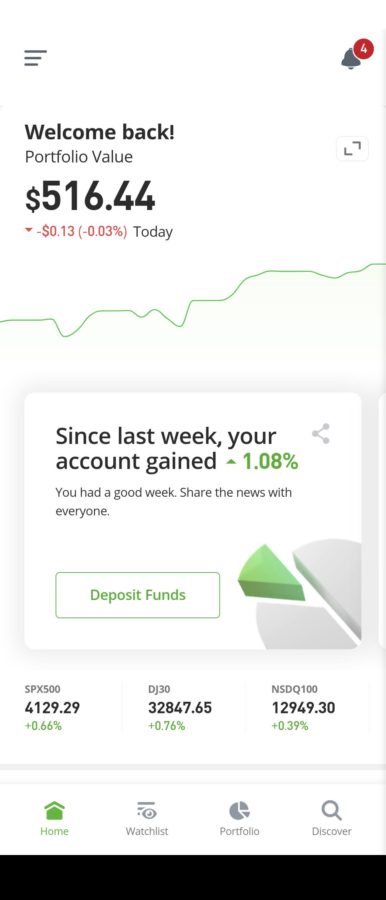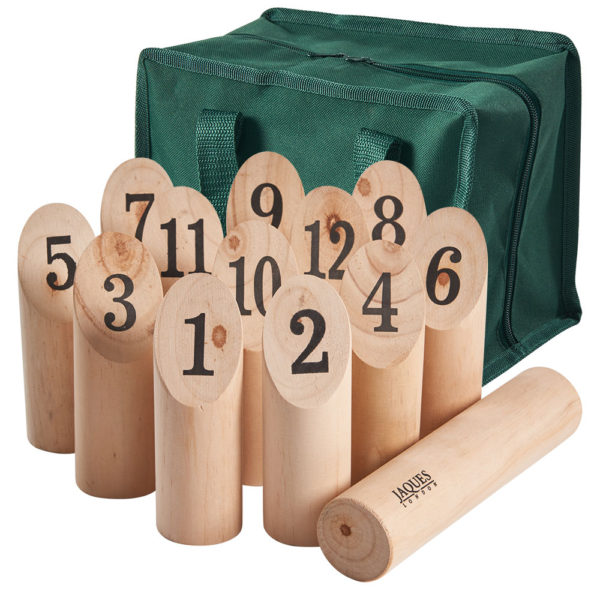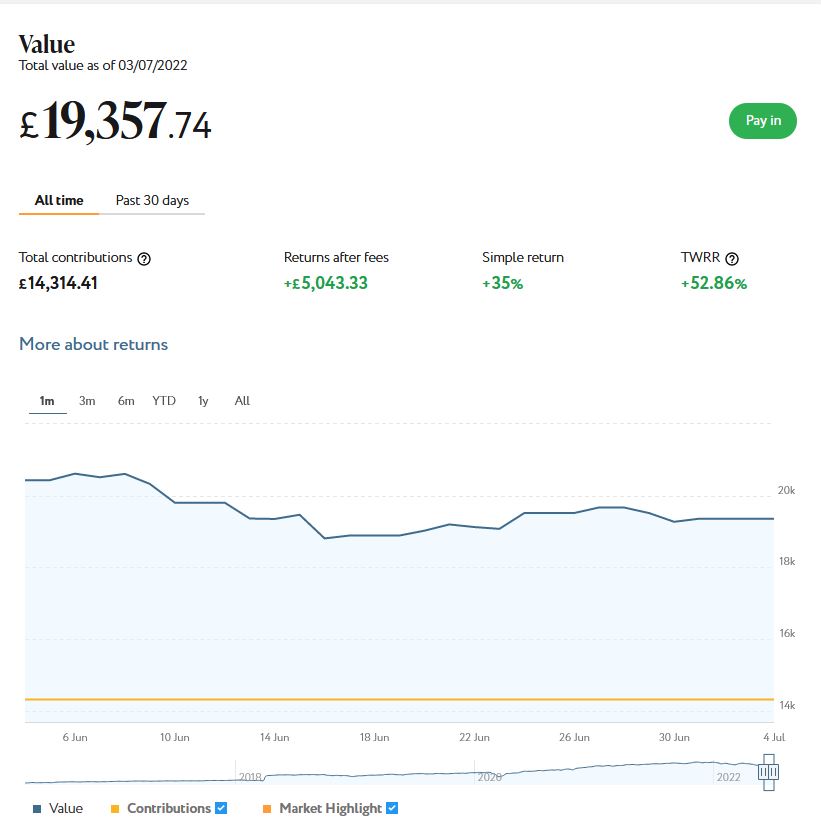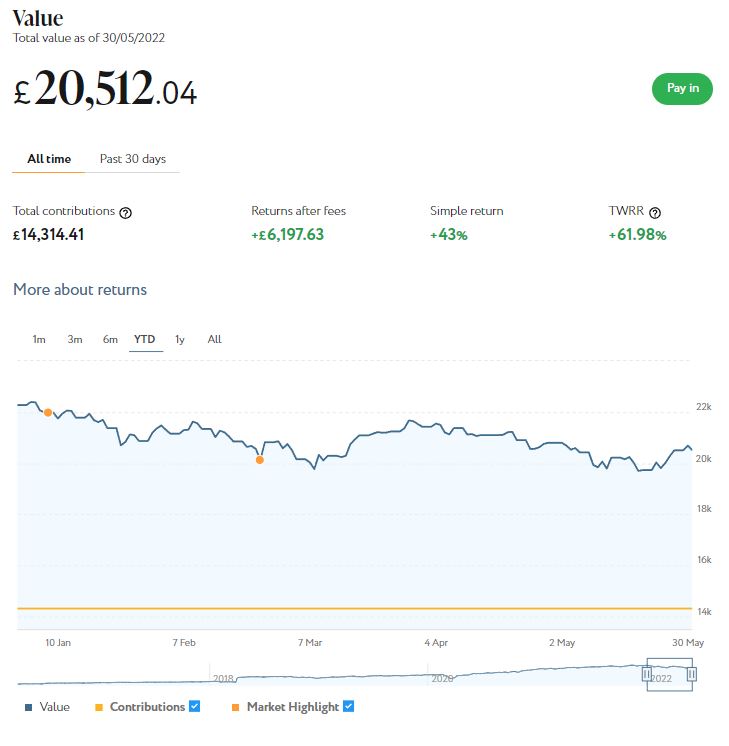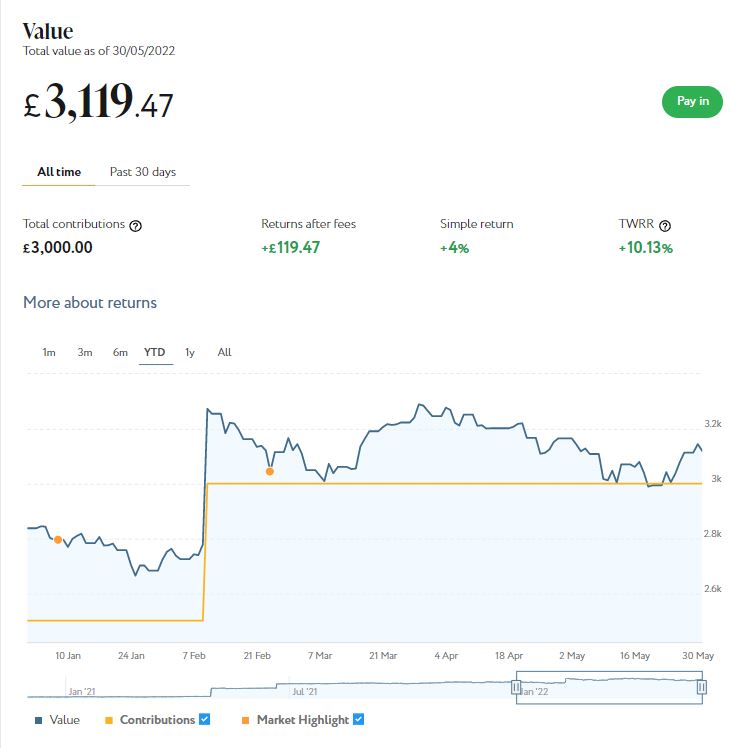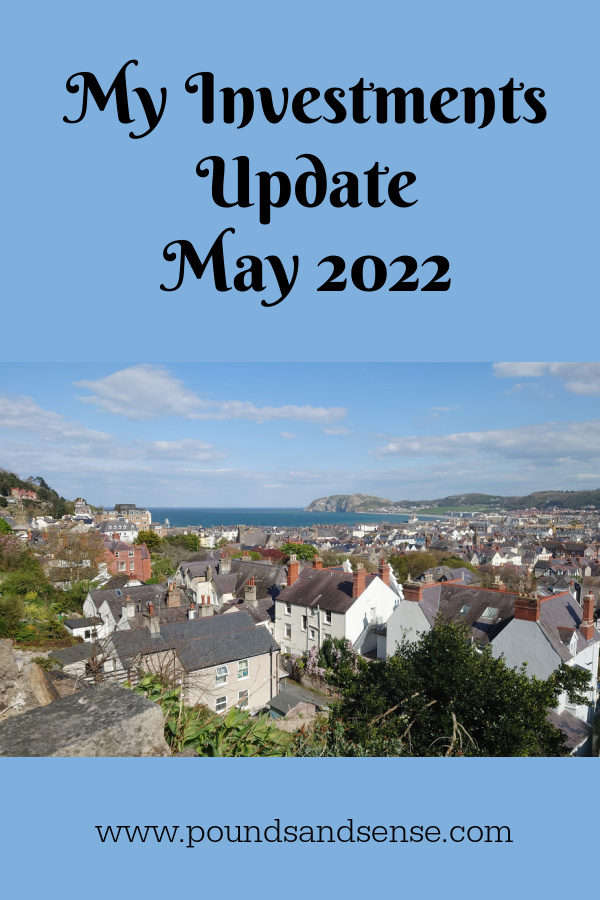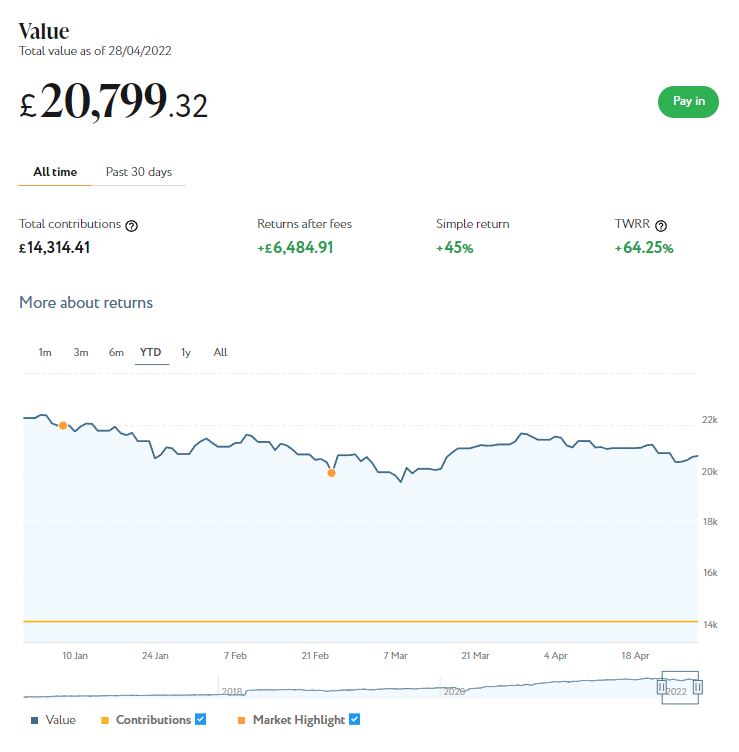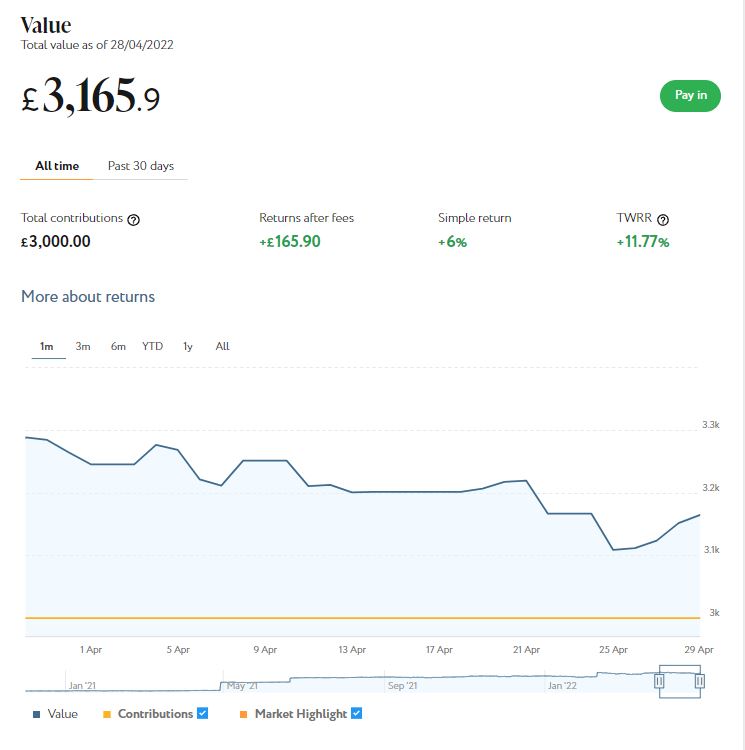My Investments Update September 2022
Here is my latest monthly update about my investments. You can read my August 2022 Investments Update here if you like
I’ll begin as usual with my Nutmeg Stocks and Shares ISA. This is the largest investment I hold other than my Bestinvest SIPP (personal pension).
As the screenshot below of performance last month shows, my main portfolio is currently valued at £20,344. Last month it stood at £20,407 so that is a modest fall of £73.
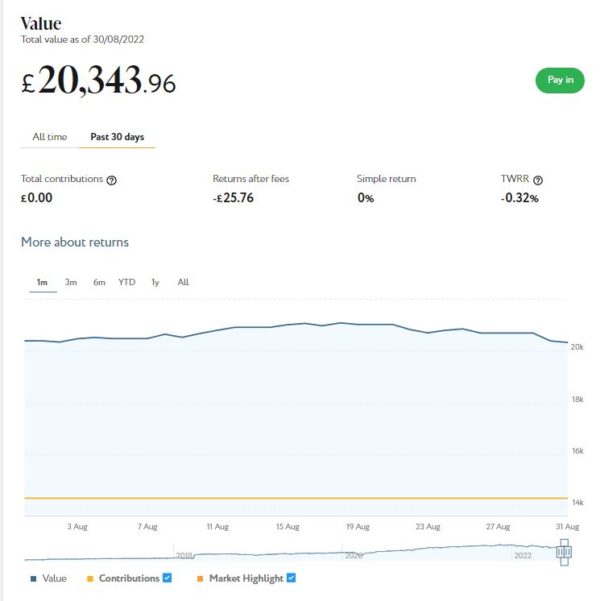
Apart from my main portfolio, I also have a second, smaller pot using Nutmeg’s Smart Alpha option. This is now worth £3,091 compared with £3,108 a month ago, another modest fall of £17.
Here is a screen capture showing performance since January 2022. As you can see, I have topped up this account several times this year.
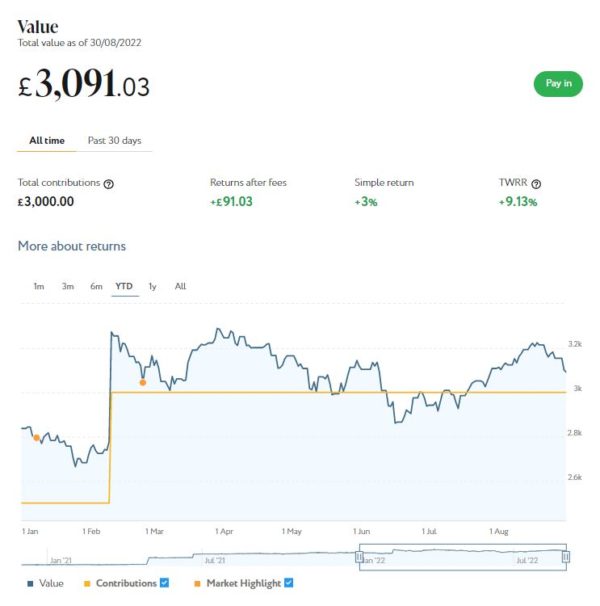
The falls are obviously disappointing, though August was a roller-coaster month and until about a week ago both portfolios were showing a good profit since the end of July. As I’ve noted previously on PAS, you do have to expect ups and downs with equity-based investments. And this year there has been no lack of volatility in world markets, caused by rising inflation, the war in Ukraine and the aftermath of the pandemic (among other things).
Even so, since I started investing with Nutmeg in 2016 – and despite everything that has happened this year – I have still made a total net return on capital of 42.12% (or 60.65% time-weighted) on my main portfolio.
I should say as well that I selected quite a high risk level for both my Nutmeg accounts (9/10 for the main one and 5/5 for Smart Alpha). This has served me well generally, but I’m sure investors who selected lower risk levels will have seen fewer ups and downs over the last few months. If you also have a Nutmeg portfolio and plan to withdraw from it soon, there is certainly a case for switching to a lower risk level now.
You can read my full Nutmeg review here (including a special offer at the end for PAS readers). If you are looking for a home for your annual ISA allowance, based on my experience over the last six years, they are certainly worth considering.
If you haven’t yet seen it, check out also my blog post in which I looked at the performance of Nutmeg fully managed portfolios at every risk level from 1 to 10 (as mentioned, my main port is level 9). I was actually pretty amazed by the difference the risk level you choose makes. If you are investing for the long term (and you almost certainly should be) opting for a hyper-cautious low-risk strategy may not be the smartest thing to do.
My Assetz Exchange investments continue to perform well. Regular readers will know that this is a P2P property investment platform focusing on lower-risk properties (e.g. sheltered housing). I put an initial £100 into this in mid-February 2021 and another £400 in April. In June 2021 I added another £500, bringing my total investment up to £1,000.
Since I opened my account, my AE portfolio has generated £70.81 in revenue from rental and £85.35 in capital growth, a total of £156.16. That’s a decent rate of return on my £1,000 investment and does illustrate the value of P2P property investment for diversifying your portfolio when equity markets are volatile (as at the moment).
I now have investments in 23 different projects and all are performing as expected, generating rental income and in most cases showing a profit on capital as well. So I am very happy with how this investment has been doing. And it doesn’t hurt that most projects are socially beneficial as well.
- To control risk with all my property crowdfunding investments nowadays, I invest relatively modest amounts in individual projects. This is a particular attraction of AE as far as i am concerned. You can actually invest from as little as 80p per property if you really want to proceed cautiously.
My investment on Assetz Exchange is in the form of an IFISA so there won’t be any tax to pay on profits, dividends or capital gains. I’ve been impressed by my experiences with Assetz Exchange and the returns generated so far, and intend to continue investing with them. You can read my full review of Assetz Exchange here. You can also sign up for an account on Assetz Exchange directly via this link [affiliate].
Another property platform I have investments with is Kuflink. They continue to do well, with new projects launching almost every day. I currently have around £2,500 invested with them in 14 different projects. To date I have never lost any money with Kuflink, though some loan terms have been extended once or twice. On the plus side, when this happens additional interest is paid for the period in question. At present most of my Kuflink loans are performing to schedule, though two recently had their repayment dates put back by three months.
My loans with Kuflink pay annual interest rates of 6 to 7.5 percent. These days I invest no more than £200 per loan (and often less). That is not because of any issues with Kuflink but more to do with losses of larger amounts on other P2P property platforms in the past. My days of putting four-figure sums into any single property investment are behind me now!
- Nowadays I mainly opt to reinvest the monthly repayments I receive from Kuflink, which has the effect of boosting the percentage rate of return on the projects in question
Obviously a possible drawback with Kuflink and similar platforms is that your money is tied up in bricks and mortar, so not as easily accessible as cash savings or even (to some extent) shares. They do, however, have a secondary market on which you can offer any loan part for sale (as long as the loan in question is performing and not in arrears). Clearly that does depend on someone else wanting to buy it, but my experience has been that any loan parts offered are typically snapped up very quickly. So if an urgent need arises, withdrawing your money (or part of it) is unlikely to be an issue.
You can read my full Kuflink review here. They offer a variety of investment options, including a tax-free IFISA paying up to 7% interest per year with built-in automatic diversification. Alternatively you can now build your own IFISA, with most loans on the platform (including the one shown above) being IFISA-eligible.
My investment in European crowdlending platform Nibble continues to perform as advertised. My latest investment was in their Legal Strategy. These are loans that are in default and facing legal action. Nibble buy these loans at a heavily discounted rate and then seek to recover as much as possible of the money owed. The minimum investment is 10 euros and the minimum period is six months. I invested 100 euros for 12 months initially at a target annual interest rate of 12.5%.
The Legal Strategy comes with a deposit-back guarantee. This is a guarantee to return the full investment amount at the end of the investment period and a minimum yield of 9% per year. The actual yield depends on how successful recovery efforts prove, so in practice you may end up with a return of anywhere between 9% and 14.5%. All has gone to plan so far, but I will obviously continue to report on this in the months ahead.
- You can read my updated review of Nibble here if you like. You can also sign up directly on the Nibble website [affiliate link].
As mentioned last time, I recently set up an account with investment and trading platform eToro, using their popular ‘copy trader’ facility. I chose to invest $500 (about £412) copying an experienced eToro trader called Aukie. My investment initially dipped, but I am now about $21 in profit. In these turbulent times I am quite happy with that. But in any event I’m looking on this as a long-term investment so won’t be judging it yet. I am also considering a further investment with eToro, possibly in one of their themed portfolios. You can read my full in-depth review of eToro here.
Moving on, I had another article published on the always-excellent Mouthy Money website. This one is titled Earn a Sideline Income From Online Surveys. In this article I set out my five favourite survey sites for generating a sideline income. Surveys represent an easy, stress-free way to give your income a bit of a boost, which clearly we could all do with just now.
I had quite a busy month in August (one reason I haven’t updated the blog for a while!). In particular, I agreed to present a session for The Joy Club (an online social group for retired and semi-retired people) on the subject of budgeting in the cost of living crisis. This involved rather more work than I anticipated, as I had to prepare a PowerPoint presentation, resources list and accompanying 7000 word script. But it seemed to go down well and I enjoyed the questions and discussion at the end. I know PAS has acquired some extra readers and subscribers as a result of this event, so a very warm welcome if that includes you!
Also in August I enjoyed a break in Lavenham in Suffolk, said to be England’s best-preserved medieval village. My original reason for going was to see Darkside, my favourite Pink Floyd tribute band (see photo below). But I thought I’d make a holiday of it as well, so I ended up staying four nights.

Lavenham is a charming, picturesque place, with various interesting historical buildings you can visit. These include the early 16th century Guildhall and Little Hall, a former wool merchant’s house. I plan to write a post about my Lavenham trip soon.
Finally, I know a lot of people are extremely anxious about the cost-of-living crisis. As I said in my Joy Club presentation last week, though, it’s important not to panic. I recommend a three pronged-approach of maximizing your income, minimizing your expenditure, and budgeting carefully (using your resources as effectively as possible, in other words). Bear in mind, also, that various government support measures have already been announced to try to mitigate the worst effects of the crisis. And once a new PM is (finally!) in place, more will certainly follow.
In the meantime, please do check out some of the other posts on Pounds and Sense for additional advice and resources, especially in the Making Money and Saving Money categories.
That’s all for today. As always, if you have any comments or queries, feel free to leave them below. I am always delighted to hear from PAS readers 🙂
Disclaimer: I am not a qualified financial adviser and nothing in this blog post should be construed as personal financial advice. Everyone should do their own ‘due diligence’ before investing and seek professional advice if in any doubt how best to proceed. All investing carries a risk of loss.
Note also that posts may include affiliate links. If you click through and perform a qualifying transaction, I may receive a commission for introducing you. This will not affect the product or service you receive or the terms you are offered, but it does help support me in publishing PAS and paying my bills. Thank you!

